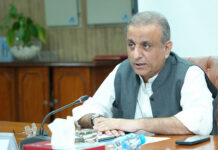Flood-related supply disruptions and temporary border closures have caused an increase in the prices of several essential commodities, leading to an inflation forecast of 5-6% for October 2025, according to the monthly Economic Update and Outlook by the Ministry of Finance.
The ministry said in its outlook that Pakistan’s economy has maintained its recovery path despite flood-related disruptions. Industrial activity remains resilient, supported by a rebound in large-scale manufacturing, particularly in cement, automobiles, and allied sectors, while exports and remittances are showing steady improvement. The external sector remains stable, with a current account surplus recorded in September 2025, amid robust remittance inflows. Inflation, though temporarily affected by food-supply pressures, is expected to remain contained within the target.
The successful IMF review under the Extended Fund Facility (EFF) and the Resilience and Sustainability Facility (RSF) reaffirms confidence in Pakistan’s reform trajectory and prudent macroeconomic management. Upgrades by global rating agencies Fitch, S&P, and Moody’s are a reflection of renewed investor confidence.
Continued progress in privatisation, digital governance, and CPEC Phase 2.0 joint ventures underscores the government’s commitment to fiscal consolidation, structural transformation, and sustainable, inclusive growth.
Due to recent floods, there is a risk of inflationary pressures. However, the government remains firmly committed to maintaining fiscal discipline, keeping inflation within the target, and providing targeted social protection within a sound and forward-looking macroeconomic policy framework.
The ministry said that the positive developments are reflected in a sharp decline in Pakistan’s sovereign default risk, with its Credit Default Swap probability declining by 2,200 basis points over the past 15 months. Moreover, Pakistan’s Sustainable Financing Framework has earned an “Excellent” alignment score from Sustainable Fitch, certifying full compliance with global standards for green, social, and sustainable bonds and loans.
According to a preliminary assessment, the recent flood has caused Rs. 430 billion in losses to the agriculture sector, damaging crops: rice, cotton, sugarcane, maize, fodder, and vegetables. Nevertheless, recent indicators suggest that recovery efforts are underway, supported by increased agricultural credit, higher machinery imports, and improved fertiliser offtake.
During Jul-Aug FY2026, the agricultural credit disbursement jumped 19.5% to Rs. 404.2 billion from Rs. 338.2 billion last year. During FY2026 Jul-Sep, imports of agricultural machinery increased by 31.3% to $39.3 million compared to $29.9 million last year. During Kharif 2025 (Apr-Sep), urea offtake recorded at 3,105 thousand tonnes (13.1% higher than Kharif 2024) and DAP offtake was 650 thousand tonnes (1.2% higher than Kharif 2024). LSM Registers Steady Growth Backed by Automobile and Construction Demand.
Large-Scale Manufacturing (LSM) registered a growth of 4.4% during Jul-Aug FY2026 with 12 sectors recording positive growth, including wearing apparel, non-metallic mineral products, food, electrical equipment, automobiles, and tobacco. In August 2025, LSM marginally grew by 0.5% on a year-on-year (YoY) basis, while on a month-on-month (MoM) basis it declined by 2.7%.
During Jul-Sep FY2026, the performance of the automobile sector remained encouraging, supported by a substantial increase in the production of cars (74.0%), trucks & buses (105.2%), and jeeps & pick-ups (48.7%). Similarly, cumulative cement dispatches reached 12.2 million tonnes, up 16.2% in Q1-FY2026. Domestic dispatches were recorded at 9.6 million tonnes (15.1% increase), while exports rose by 20.8% to 2.6 million tonnes.
CPI inflation recorded at 5.6% (YoY) in September 2025 as compared to 3.0% in the previous month and 6.9% in September 2024. On a MoM basis, it increased by 2.0% in Sep 2025 as compared to a decrease of 0.6% in the previous month and a decrease of 0.5% in Sep 2024. During Jul-Sep FY2026, it was recorded at 4.2% against 9.2% last year.
Major contributing factors of YoY inflation include Education (10.7%), Health (10.6%), Clothing & Footwear (8.0%), Non-Perishable Food (6.5%), Restaurants & Hotels (6.1%), Transport (4.2%), Furnishing & Household Equipment Maintenance (4.1%), Housing, Water, Electricity, Gas & Fuels (3.7%), Alcoholic Beverages & Tobacco (3.4%), and Communication (0.4%). Decline was observed in perishable food items (3.7%) and Recreation & Culture (2.7%). The Sensitive Price Indicator for the week ending October 23, 2025, increased by 0.22%. During the week, out of 51 items, prices of 20 items increased, 6 items decreased, and 25 items remained stable.
During Jul-Aug FY2026, net federal revenues surged by 231.4% to Rs. 3,269.8 billion, compared to Rs. 986.7 billion in the same period last year. This remarkable improvement was driven by a 721.1% jump in non-tax revenues and a 14.1% rise in FBR tax collections. The surge in non-tax revenues was mainly led by higher State Bank of Pakistan profits, supplemented by increased receipts from dividends, defence receipts, Windfall Levy against crude oil, the Gas Infrastructure Development Cess, and the petroleum levy. During Jul-Sep FY2026, FBR’s tax collection rose to Rs. 2,884.4 billion, up 12.5%. On the expenditure side, total outlays increased modestly by 7.6% to Rs. 1,760.6 billion, reflecting prudent fiscal management. Consequently, the federal fiscal balance recorded a surplus of Rs. 1,509.2 billion, compared to a deficit of Rs. 648.8 billion last year. The primary balance also improved sharply, posting a surplus of Rs. 2,938.9 billion, up from Rs. 49.4 billion in the corresponding period.
The current account recorded a deficit of $594 million during Jul-Sep FY2026, compared to $502 million last year. However, in September FY2026, the current account turned to a surplus of $110 million. Goods exports rose 6.5% to $7.9 billion, while imports increased 8.3% to $15.4 billion, resulting in a trade deficit of $7.5 billion during Jul-Sep FY2026 compared to $6.8 billion last year. Key gains of exports were observed in knitwear (12.2%), garments (6.1%), and bedwear (7.3%). Import increases were recorded in petroleum products (3.1%) and palm oil (34.1%), while petroleum crude decreased (0.2%). Service exports grew by 14.8% to $2.2 billion; imports increased 11.2% to $3.1 billion, with a service trade deficit of $931 million against $900 million last year. IT exports increased by 20.4% to $1.1 billion. Remittances were up 8.4% to $9.5 billion during Jul-Sep FY2026, led by inflows from Saudi Arabia (24.2% share) and UAE (20.8%). Net FDI inflows declined, recording at $568.8 million. Main sources remained China ($188.6 million) and Hong Kong ($96.0 million). Sector-wise, power ($244.3 million) and financial services ($180.2 million) attracted the most FDI. Private and public FPI recorded net outflows of $121.5 million and $511.8 million, respectively. As of October 17, 2025, foreign exchange reserves stood at $19.9 billion, including $14.5 billion with SBP.
During the period 01st July–03rd October, FY2026 money supply (M2) showed negative growth of 2.6% as compared to negative growth of 1.9% last year. Within M2, Net Foreign Assets (NFA) of the banking system increased by Rs. 173.8 billion as compared to an increase of Rs. 188.6 billion last year. Whereas Net Domestic Assets (NDA) of the banking system decreased by Rs. 1245.5 billion as compared to a decrease of Rs. 863.9 billion last year. Under the borrowing for budgetary support, the government has retired Rs. 2039.6 billion against the retirement of Rs. 1282.0 billion last year. The private sector has retired Rs. 18.6 billion as compared to retiring Rs. 297.0 billion last year. In the capital market, the Pakistan Stock Exchange (PSX) continued its bullish momentum in September 2025, with the KSE-100 Index climbing 16,875 points to close at 165,493. The Market capitalisation expanded by Rs. 1,608 billion, reaching Rs. 19,264 billion by the month-end. As of October 22, 2025, the KSE-100 Index stood at 166,553 points, with total market capitalisation recorded at Rs. 19,212 billion.
In September 2025, the Bureau of Emigration & Overseas Employment registered 73,545 workers, a 43% increase from 51,444 in August 2025. The Pakistan Poverty Alleviation Fund, in partnership with 26 organisations, disbursed 5,370 interest-free loans worth Rs. 322.6 million during September 2025. Since 2019, a total of Rs. 120.7 billion has been provided to the borrowers. During Jul-Aug FY2026, Rs. 14.63 billion was spent under the BISP, representing a 60.0% decrease compared to last year.
























